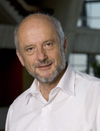2010 is around the corner
 |
Pier Oddone |
Between the colloquium at Johns Hopkins last Thursday and a presentation to the URA Board of Trustees yesterday back in Washington, D.C., I made a quick trip to Irvine, Calif., to make a presentation to the National Academy of Science's Board on Physics and Astronomy. My presentation was on the Fermilab program. It was part of an analysis by the BPA on the results of EPP2010, the broad NAS committee that made recommendations for the development of particle physics in the U.S. While it seems yesterday that we were dealing with EPP2010 — and 2010 was a few years away — now 2010 is around the corner. EPP 2010 was quite different from other NAS committee in that it included notable individuals outside our field. It was charged to prioritize opportunities and develop recommendations for the next 15 years. Dennis Kovar, head of the Office of High Energy Physics in DOE, Mel Shochet, chair of HEPAP, and Barry Barish among others, also made presentations to the BPA at Irvine.
In their most succinct form, the principal recommendations of EPP2010 were: 1) Fully exploit the opportunities afforded by the construction of the Large Hadron Collider (LHC) at the European Center for Nuclear Research (CERN); 2) Plan and initiate a comprehensive program to become the world-leading center for research and development on the science and technology of a linear collider, and do what is necessary to mount a compelling bid to build the proposed International Linear Collider (ILC) on U.S. soil and 3) Expand the program in particle astrophysics and pursue an internationally coordinated, staged program in neutrino physics. Underlying these recommendations were the strong statements made by EPP2010 about the importance of the US being a leader in this field at a time of great excitement in physics.
These recommendations, within the budgetary and political constraints of the intervening years, have been influential for all subsequent plans. Clearly the LHC has not yet provided the drive or answers for determining any future lepton collider. R&D on the ILC continues world-wide with a target date for completion of the next plan in 2012. While the US has not declared its intention of being the host of such machine, it is not far behind in the development of the required technologies. The astrophysics and neutrino programs in the meantime have moved along nicely. We have not reached global coordination of the neutrino program, but we continue informal discussions to have complementary programs as much as possible with fellow laboratories in Japan. In the meantime, the U.S. plan with emphasis on the excitement at the three frontiers of particle physics has found resonance both in the administration and Congress.
|